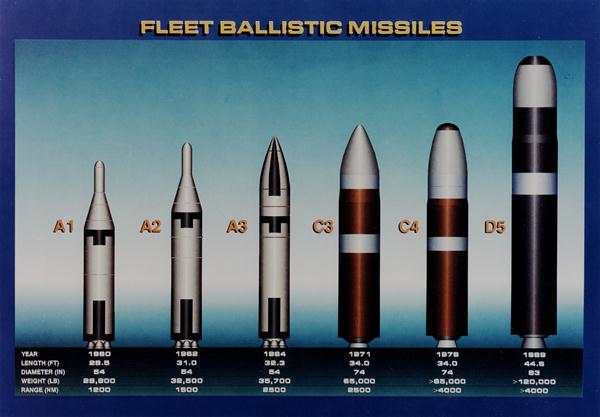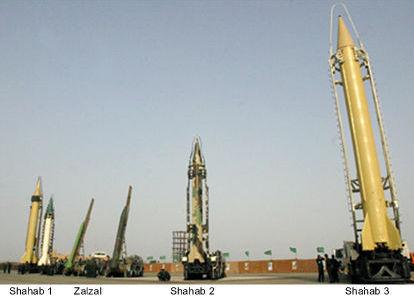tariqjavaid
com.jpg)
Age: 61 
4605 days old here
Total Posts: 5615
Points : 209
Location:
Quetta, Pakistan
Status : Offline |
Subject : What is a Ballistic Missile?
The modern ballistic missile is based on a design in use since the German V-2 rocket which the Nazis used during World War II to terrorize and kill the British. But because the warhead used conventional explosives—roughly one ton of TNT—the damage was limited. Nevertheless, ballistic missiles have become both the essential long range artillery of modern warfare, and the means par excellence of exerting international pressure. Much of their current usefulness depends on the current lack of defenses against them.

A ballistic missile can be launched from land, from a silo, from mobile platforms on trucks or trains, from submarine or ship, or from an airplane. The U.S., Russia, the UK, France, and China each also have missiles (SLBMs), that are launched from submarines underwater, at sea, or in port. After launch, a ballistic missiles arches up from one point, and lands at another point. All rockets, from fireworks to massive space launchers, carry both fuel and some form of oxygen. Because they do not burn oxygen from the air, ballistic missiles can fly beyond earth’s atmosphere. Long range ballistic missiles spend a majority of their flight time in the vaccum of space. Short-range ballistic missiles may because they can fly where there is little or no air resistance, they can reach speeds up to 20 or more times the speed of sound—some 15,000 miles per hour (7km/sec)—speeds which allow ballistic missiles to go between continents. A missile is called ballistic because, just as one would throw a ball or spear, the rocket’s engine gives the missile an initial push, after which its flight is affected only by gravity. Ballistic missiles do not fly. They go up, and they come down.

Ballistic missiles are not to be confused with cruise missiles. The former are unmanned projectiles; the latter are pilotless airplanes, either remote controlled or pre-programmed. They fly through the air, and only through the air. The engines of cruise missiles, like those of aircraft, burn oxygen from the air. Like all other kinds of aircraft, cruise missiles are held up by the flow of air over their wings. Their engines work throughout the flight, not just at the beginning. Cruise missiles fly horizontally rather than in arches, reach only about twice the speed of sound, and typically travel from tens to hundreds of miles. But while cruise missiles and defenses against them are important to modern warfare, these technologies are quite different from those of ballistic missiles and ballistic missile defenses.A ballistic missile is a tube from approximately thirty to over one hundred feet tall, almost completely filled with either liquid or solid fuel. At the bottom of the tube are the engines and direction controls—either fins (as in older models) or small sideways thrusters. Liquid fuel is typically some distillate rich in carbon and hydrogen. In the engines, this combines with liquid oxygen, ignites, and provides thrust. Solid fuel consists of some powdered metals such as zinc or magnesium, combined with a solid source of oxygen, and something that binds the mixture and regulates the burn. The engines simply direct the resulting thrust. But once solid fuel missiles are lit, the fuel will burn until done. At the top of the missile are its brains—the guidance systems. Above these is the payload. Modern guidance systems begin with instruments that measure how fast, how long, and in what direction the missile has moved. Periodically, the information generated by this system is updated by checking the missile’s position against known stars, (or against signals from the U.S. Global Positioning System satellites). The guidance system then compares this information with the course pre-programmed into it, and guides the missile accordingly. Modern U.S. ballistic missiles have a high probability of putting their payload into a fifty-yard circle from intercontinental distances. It is also possible to give ballistic payloads the capacity to receive signals late in flight, and to make small maneuvers. When this happens, they are no longer strictly ballistic. With such extra guidance, the payload can be delivered within ten feet or so of the target. The payload may be a satellite programmed to be launched into orbit, or it may be a warhead—a conventional high explosive, a chemical weapon, or a nuclear weapon. The warhead may be programmed to hit a variety of targets at various ranges. There may also be a number of warheads aboard a single missile, which may each be programmed to hit a different target: these are called Multiple Indpendently-targetable Reentry Vehicles, or MIRVs. These warehads may of course be nuclear weapons, which can be made to detonate in the ground to destroy a “hard” target on or below the ground, or in the atmosphere to kill human beings. The destructive capacity of the warhead aboard, however, has nothing to do with the technology required to destroying its means of delivery. The science of destroying a missile carrying a nuclear weapon is identical to the science of destroying the same missile carrying a mass of concrete as a payload. The increased destructive capacity of warheads delivered by ballistic missiles made even older and more inaccurate missiles more, not less, useful tools in warfare. The very usability of ballistic missiles and the possibility of warfare involving the nuclear warheads they carry is what makes ballistic missile defense such a priority.
no likes.
|